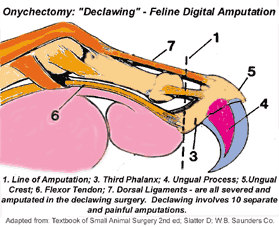|
|
Declawing
I can't tell you how many times I have heard people say "If I only knew what declawing really was, I would have never had it done". We as pet owners should always educate ourselves on any procedure that is being done on our companion animals. If you are considering declawing your cat there are some important facts that you should know first.
Declawing is a serious surgery. Your cat's claw is not a toenail. It is actually closely adhered to the bone. So closely adhered that to remove the claw, the last bone of your cat's claw has to be removed. Declawing is actually an amputation of the last joint of your cat's "toes". Here is a diagram to help you envision it. You can see why many, myself included, consider declawing an inhumane act.

It is a painful surgery, with a painful recovery period. And remember that during the time of recuperation from the surgery your cat would still have to use its feet to walk, jump, and scratch in its litter box regardless of the pain it is experiencing.
Unlike most mammals who walk on the soles of the paws or feet, cats are digitigrade, which means they walk on their toes. Their back, shoulder, paw and leg joints, muscles, tendons, ligaments and nerves are naturally designed to support and distribute the cat's weight across its toes as it walks, runs and climbs. A cat's claws are used for balance, for exercising, and for stretching the muscles in their legs, back, shoulders, and paws. They stretch these muscles by digging their claws into a surface and pulling back against their own clawhold - similar to isometric exercising for humans. This is the only way a cat can exercise, stretch and tone the muscles of its back and shoulders. The toes help the foot meet the ground at a precise angle to keep the leg, shoulder and back muscles and joints in proper alignment. Removal of the last digits of the toes drastically alters the conformation of their feet and causes the feet to meet the ground at an unnatural angle that can cause back pain similar to that in humans caused by wearing improper shoes. Is there any wonder that many declawed cats suffer from behavioral problems.
Many vets and clinic staff deliberately misinform and mislead clients into believing that declawing removes only the claws in the hopes that clients are left with the impression that the procedure is a "minor" surgery comparable to spay/neuter procedures and certainly doesn't involve amputation (partial or complete) of the terminal-toe bone, ligaments and tendons. Some vets rationalize the above description by saying that since the claw and the third phalanx (terminal toe bone) are so firmly connected, they simply use the expression "the claw" to make it simpler for clients to "understand". Other vets are somewhat more honest and state that if they used the word "amputation", most clients would not have the surgery performed! In many European countries declawing is termed "inhumane" and "unnecessary mutilation. It is considered ILLEGAL.
As the owner of 12 CLAWED cats, I have 6 scratching posts and the same couch WITH NO SHRED MARKS for 11 years.
It amazes me that a person will take the time to have their cat declawed, but not take the time to simply teach their cat to use the scratching post instead of the couch or how many have had their cats declawed because they were ruining the furniture, but never bothered providing a scratching post for their cat to use in the first place.
Please do NOT declaw your cat.
-Association of Veterinarians for Animal Rights (AVAR):
“The AVAR believes that people who desire cats as companions should endeavor to learn about feline behavior prior to adopting a cat. If certain behavioral traits are unacceptable, then the desire for a cat should be reconsidered.”
Click HERE for more links and information regarding this procedure.

|
| |

